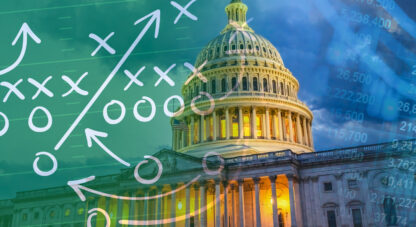Transitory Goldilocks + De-dollarization = a Golden 2024
Welcome to the new year, beloved HAI readers. It promises to be a doozy. History generally suggests and conventional wisdom confirms that the incumbent party in a presidential election year becomes very generous. It strives to keep the fiscal spigot flowing full-blast in order to keep the labor market and stock market propped up. Similarly, the Federal Reserve has indicated that it expects to ease monetary policy with stimulative rate cuts in 2024. The bellwether S&P 500 stock index has technically recovered to near-all-time highs. Market sentiment now eagerly anticipates an imminent breakout to new-highs that will initiate the start of the market’s next decades-long bull run.
After all, as long as policymakers are masters of the financial universe and can deliver Goldilocks financial and economic conditions by hook, crook, or alchemy, what’s to stop financial asset markets (essentially the Federal Reserve-backed global liquidity dumping ground of choice) from a perpetual march to higher prices?
The short answer is: maybe nothing in the near-term. Confidence in an omnipotent Fed and a perpetual Goldilocks environment still reign supreme, so the technical set-up for new all-time market highs is hard to bet against at present.
The real question at hand isn’t whether we will or won’t make new all-time highs. There’s a far more consequential question at hand: Are we starting a renewed up-cycle on top of the ongoing decades-long financial asset bubble—as many market participants now believe—or are we wrapping up the old cycle with its old rules as we face the reality of a brand new regime?
HAI firmly favors the latter interpretation of our modern moment, but that doesn’t mean the stock market party and bubble-market pricing are necessarily over just yet. Markets have an extensive and well-proven track record of making hay while the sun shines and keeping the party going right up to the point where the rain well and truly pours. At our current juncture, it’s important to remember that the history of late-stage economic and market cycles is always “party hardy till it’s pull-the-plug; party over.” Once the switch flips, brace for whiplash as prices and the market narrative pendulum swing far and fast.
At present, for HAI, the late-stage unsustainability of our current market regime is well understood. Attempting to gauge how long the current late-cycle dynamics can be maintained into the new year is a much tougher task. In 1974, rock band Ace posed the question in their hit single “How Long”: “How long has this been goin’ on?” In 2024, HAI must ask, how long can this keep goin’ on? It’s a crucial and notoriously difficult question that we will doubtless revisit repeatedly throughout the new year.
That said, however, make no mistake: our policy-fueled financial asset bubble is inherently unsustainable in current form. As naturalist Alexander Skutch observed; “The common feature which unites the activities most consistently forbidden by the moral codes of civilized people is that by their very nature they cannot be both habitual and enduring because they tend to destroy the conditions which make them possible.” An unsustainable activity is defined as such because it cannot be both habitual and enduring. This is the reality of our decades-long activist fiscal and monetary policy regime as it aims at unnaturally conjuring perpetual Goldilocks conditions.
Again, Goldilocks conditions are the key to maintaining the stock market bubble, and we can think of them as a simultaneous combination of maintained economic growth, low-interest rates, low government interest expense, fiscal sustainability, low inflation, and stable bond and currency markets. But despite providing the ideal environment for rising stock prices, this particular Goldilocks setting of multiple economic variables was never going to maintain itself in a constant and stable fixed balance in a natural economy. Goldilocks conditions are naturally fleeting; economic variables are naturally in flux.
It was the initial condition of relative Goldilocks that first allowed policymakers the flexibility to use activist and increasingly radical policy tools to unnaturally maintain the fleeting condition every time it began to fall apart. Initially and increasingly, the activist policy “tools” were utilized to support the economic growth component of the Goldilocks equation each time it faltered. After many years of the habitual use of radical activist policy measures, however, rather than Goldilocks, we now have an inflation problem, a fiscal sustainability problem, a government interest expense problem, and a higher interest rate problem (in response to the inflation problem) that is threatening economic growth for the rate-sensitive private sector. In short, we are watching Skutch’s unsustainability paradox play out in front of our eyes. In aiming to control and contort natural economic law by habitual use of unnatural and radical activist policy measures, we are destroying the conditions that make Goldilocks possible in the first place.
Nevertheless, despite the degenerative, self-defeating effects rapidly accumulating because of intensified policy malpractice, broad markets maintain steadfast confidence that policymakers will reconstitute Goldilocks again through the use of even more radical policy alchemy. HAI strongly disagrees—believing instead that from a policy perspective we are the snake eating its tail. If policymakers can no longer deliver Goldilocks consistently, sustainably, and perpetually, then bubbled-up financial asset prices face the material risk of a significant repricing.
The manner in which Goldilocks breaks down, however, is important. If the inflation variable is sacrificed in favor of supporting economic growth, then an inflationary fire scenario trending towards crack-up-boom dynamics may result. If growth is sacrificed in favor of fighting inflation, then expect recessionary ice.
This week’s data was mixed, but nevertheless offered some potentially important insights on the all-important question of the economic growth trajectory. Early in the week, ISM US Manufacturing PMI for December came in at 47.4 vs. an estimated 47.1, up from the previous print of 46.7. The good news is that it was slightly better than expected and an improvement from the previous month. The bad news is that, at a reading under 50, manufacturing remained in contraction for the 14th consecutive month. Furthermore, new orders, the most leading indicator, disappointed with a sizable miss at 47.1 vs. estimates for 49.4. The print was also a downturn from last month’s 48.3 read. In short, we still have no manufacturing upturn to speak of.
Recall that while manufacturing is a much smaller portion of the economy than services, it historically leads services. So far, while manufacturing has undergone a recessionary contraction, the larger services economy has remained in expansion and has been responsible for keeping aggregate economic growth positive. With that said, this week’s ISM Services PMI offered a potentially significant curveball.
While the December ISM Services PMI remained in modest expansion at 50.6, it fell notably from last month’s 52.7 reading and significantly missed expectations for 52.6. More importantly, under the headline reading, the micro data flashed some ominous warning signals. New orders (again, a leading indicator) took a big hit, down to 52.8 from 55.5 previously, and well below expectations for an increase to 56.1.
Even worse, the services employment gauge cratered. In November, employment held a modest expansion at 50.7. December was expected to nudge up to a 51 reading. In HAI’s view, the five-alarm data bombshell of the week was actual services PMI employment falling through the trapdoor to the recessionary sub-basement at 43.3. It was a truly stunning tumble, and a monumental miss of expectations. It was so stunning that highly respected Bloomberg economist Anna Wong, in a state of disbelief, was compelled to fact-check the release with ISM to confirm it wasn’t an error. Well, ISM confirmed—no error. Now at a 43.3 reading, the ISM services PMI employment index has never been this low outside of recession. What a difference a month can make.
As HAI has reiterated throughout 2023, a weakening in the services economy that hits employment is ultimately the key to recession. If the latest ISM services PMI employment crash into deep contraction holds into 2024, then the ongoing “recession watch” will quickly upgrade to “recession warning” and the recession readiness DEFCON setting will increase in severity from 3 to 1.
Also confirming the sudden services employment weakness was another big drop in temporary help services employment. That is one of the most leading employment indicators, and it’s also now unambiguously recessionary as temp help contracts at a smoothed rate of -9.1%.
Anna Wong was so unsettled by the confirmed ISM services employment number that she questioned the rosy non-farm payroll establishment survey data out Friday morning. As Anna put it, the ISM data “really begs the question of why nonfarm payroll increased by that much.” HAI has no answer, but offers a tip of the hat to Anna for one heck of a good question.
The non-farm payroll data was indeed mysterious. Coming in at 216,000, the headline survey number was surprisingly strong. It not only registered above most estimates, but was the highest number in four months. This was particularly mysterious in light of the fact that hours worked, an important gauge for labor market strength, dropped below pre-Covid (undistorted) levels. In addition, despite the relative headline strength in the non-farm establishment survey, big negative revisions to previous months (we’ve now had negative revisions for 10 of the last 11 months) took the shine out of the strong labor market narrative put forth by the financial media following the data release. In fact, negative revisions this month put the labor market back on a track consistent with the aggregate data from previous roads to recession.
Furthermore, the household survey—the companion to the establishment survey—completely and uncharacteristically diverged with a massive 683,000 job collapse that was the most extreme since the forced Covid shutdown of the economy. Even worse from a job quality perspective, the coveted full-time jobs category took the biggest hit. In fact, the Bureau of Labor Statistics reported that in December the number of full-time jobs plunged by 1.531 million, the biggest monthly drop since the peak record monthly crash during the Covid-forced shutdown of the economy.
In short, the service sector data and labor market updates need to be watched like a hawk in the new year. We may be far closer to recession than most assume, and certainly far closer to recession than markets are priced for at present.
If economic strength maintains, fiscal deficit spending continues to pump full-spigot into the election, and the Fed begins to cut interest rates before inflation reaccelerates, then the stock market bubble-bash could continue for a number of months into 2024 before Goldilocks finally unravels. If, however, this week’s key data proves a harbinger of things to come, recession may already be knocking on the door. It might be too late for a final bubble blow-off in financial asset prices.
To be sure, if employment is now at risk, it certainly lends credibility to famed economist David Rosenberg’s view, expressed this week, that “it’s premature to throw in the recession towel like so many others have [just] because it hasn’t happened yet.” As the always-colorful Rosenberg told CNBC, that would be like “expecting no winter because there hasn’t been any snow in December.”
For HAI, the favored asset in the new year remains the same as the favored asset of the old year. Given the complex interplay between markets, economy, policy, and politics in the current set-up, HAI maintains that the best risk-adjusted play for the end of Goldilocks and the resulting policy confidence bubble-bust is golden financial insurance. Recall that while the election year effect is usually stock market positive, the election year didn’t save anyone from epic pain in either 2000 or 2008.
This week also provided an additional extremely important reason (albeit related to the breakdown of Goldilocks) not to ignore gold in 2024. De-dollarization is a significant factor in considering the outlook for assets on the global markets. Amid a crowded list of macro considerations vying for investor attention at present, de-dollarization can easily be overlooked and underappreciated.
HAI discussed the de-dollarization trend unfolding across global commodity markets numerous times in 2023. Given that gold is the choice, dollar alternative, neutral settlement reserve asset, de-dollarization of commodity markets is highly significant for gold demand as a global reserve asset. As such, it is a key contributor to the bullish gold thesis over time and likely a significant contributor to recent record global central bank gold purchases.
HAI’s working assumption, however, has been that de-dollarization will initially take place only on the margin and over an extended period of time. Despite a marked increase in non-dollar-denominated commodity deals in 2023, HAI still assumed that non-dollar-denominated global commodity trading was still well below 10% of total physical commodity trading. This week, however, a Wall Street Journal article upset that apple cart. In the article, Natasha Kaneva, head of global commodities strategy at JPMorgan Chase, admitted that, “The U.S. dollar is getting some competition in commodities markets.” In the article, Kaneva estimated that the proportion of the world’s oil (a great proxy for the entire commodity market) that is bought and sold in other currencies, is no longer a marginal single-digit percent, but instead has already “risen to about 20%.”
The implication is three-fold. First, the non-dollar commodity market is already much larger than previously assumed. Second, the de-dollarization trend is happening much faster than expected. Third, given that the primary reasons stoking the de-dollarization trend are the risk of a breakdown of U.S. Goldilocks conditions negatively effecting the dollar and the recent geopolitical weaponization of the dollar, why should we not expect the de-dollarization trend to continue and accelerate? Again, gold is the choice, dollar-alternative, neutral settlement reserve asset for these non-dollar commodity transactions. As de-dollarization increases and accelerates, gold demand increases and accelerates.
There are just too many vital factors supporting materially higher gold prices by year-end to ignore the yellow metal in 2024. Those underweight gold and related assets may want to consider adding exposure on any further price weakness ahead of the expected eventual breakout higher. Given the increasing abundance of price supportive factors, the opportunity to do so may be fleeting.
Weekly performance: The S&P 500 dropped 1.52%. Gold was down 1.06%. Silver lost 3.20%, platinum dropped 3.71%, and palladium was down 6.51%. The HUI gold miners index was off 4.25%. The IFRA iShares US Infrastructure ETF was lower by 1.89%. Energy commodities were volatile and higher on the week. WTI crude oil gained 3.01%, while natural gas surged 15.08%. The CRB Commodity Index was up 0.79%, and copper was down 2.06%. The Dow Jones US Specialty Real Estate Investment Trust Index was down 1.98%. The Vanguard Utilities ETF was up 1.58%. The dollar index gained 1.09% to close the week at 102.13. The yield on the 10-yr U.S. Treasury popped 17 bps to end the week at 4.05%.
Have a wonderful weekend!
Best Regards,
Morgan Lewis
Investment Strategist & Co-Portfolio Manager
MWM LLC















